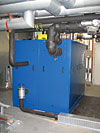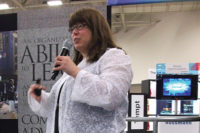
A supermarket chain in Denmark is using a carbon dioxide as part of a refrigeration system that has two refrigeration circuits linked by a plate heat exchanger.
At first glance it may seem strange that carbon dioxide, commonly thought of as the No. 1 greenhouse gas, is seen as an especially environmentally friendly alternative in refrigerant. However, the carbon dioxide used for refrigeration mainly comes from existing, mostly natural sources. For instance, more than 90 percent is produced in the fermentation processes commonly used in breweries. The rest is generated as a waste product in the chemical industry (e.g., in the production of carbonates and during air liquefaction.)
The amount of energy required for these processes and the quantities produced are so small compared with total industrial carbon dioxide emissions worldwide that they are, quite literally, negligible.
“Carbon dioxide has been used as a refrigerant since the 19th century, and temporarily took a back seat when synthetic refrigerants were introduced in the 1950s,” said Franz Kaltenbrunner, member of the executive board of Eurammon. “It was only rediscovered in the early 1990s, when researchers and those working in the refrigeration industry realized that, given today’s energy and environmental situation, carbon dioxide is in fact an ideal refrigerant.”
Carbon dioxide does not contribute to the destruction of the ozone layer and, with a reference value of 1, has a low direct global warming potential. Carbon dioxide is a colorless gas that can be liquefied under pressure, and it has a slightly acidic odor or flavor. It is neither toxic nor flammable, is chemically inert, and heavier than air.

According to Eurommon’s most recent white paper, for the operational safety of a system at high pressure, thick stainless steel is used through the entire piping network.
COOLING SUPERMARKETS
Intense research and development since it was rediscovered have led to carbon dioxide now being practical for use in many different applications. One promising field of application is supermarket refrigeration, where HFCs still dominate at present.For example, the Danish supermarket chain Super Best has installed a carbon dioxide-based cascade system at its Copenhagen branch. In Denmark, the use of more than 10 kilograms (22.04 pounds) of fluorinated gases (F-gases such as HCFCs and HFCs) in newly installed refrigeration systems has been prohibited by law since earlier this year.
Refrigeration specialists Knudsen Køling designed a refrigeration system that uses two refrigeration circuits linked by a plate heat exchanger. This allows three different temperature levels to be achieved, two for cooling and one for heat dissipation.
The first temperature level is needed in frozen food cabinets and the deep-freeze chambers in the cellar. At an evaporating temperature of -28°C (-18.4°F), the carbon dioxide is used to maintain an ambient temperature of -20°C (-4°F). The second temperature level is used for refrigerators and cold stores requiring an air temperature of a few degrees above 0°C (32°F). This is achieved by supplying the evaporators with carbon dioxide at an evaporating temperature of -10°C (14°F). The third and highest level ensures reliable heat dissipation by condensation or gas cooling, depending on the ambient temperature. Overall the cascade system has a refrigeration capacity of 150 kW.
Güntner components are used for the various temperature levels generated by the system, and the cold stores are fitted with evaporators. The heat dissipation enables an evaporator to function as a gas cooler at elevated ambient temperatures and hypercritical processing. To guarantee the operational safety of the system even at pressures of around 120 bar, Güntner used 0.7-mm-thick stainless steel for the gas cooler and the entire piping network.
Thanks to its low-noise design, the gas cooler can even be used in locations with very high noise-control requirements (e.g., residential areas). Injection to the evaporators and the cooling unit is controlled by Danfoss electrical components. There are currently 11 of these combined deep-freezing/normal refrigeration systems installed throughout Europe, as well as 100 deep freezer systems in use in supermarkets.

Two compact heat exchangers and pumping units are used for a carbon dioxide air conditioning system in the Netherlands.
PROTECTING SERVERS
Carbon dioxide is also used in air conditioning. The Dutch bank ABN Amro, for example, has used a carbon dioxide air conditioning system since 2006 to protect the powerful blade servers from overheating in the computer center at its London office. It was planned, implemented, and commissioned by Trox AITCS in cooperation with Star Refrigeration.The system consists of two compact heat exchange and pumping units. The heat exchanger uses cold water to condense carbon dioxide gas, which has been evaporated in a heat exchanger mounted on the backs of the blade server cabinets.
A stainless steel piping system connects the carbon dioxide circuit to 15 cooling units. These units have five independently powered fans which extract the heat from the cabinets. The chilled-water circuit, at 6°C (42.8°F), condenses carbon dioxide, which is pumped out to the server cabinets by centrifugal pumps, evaporated, and returned to the condenser to begin the process again, all at a constant saturated temperature of 14°C (57.2°F).
Carbon dioxide is ideal as a refrigerant for this application because it is an electrical insulator and is thus totally safe, and in comparison to a water cooling system, the operator makes an energy saving of about 30 percent. The carbon dioxide concentration in the cabinets and in the server room is monitored continuously.
The whole system has a refrigeration capacity of 300 kilowatts or 20 kW per cooling unit. This high cooling capacity makes it possible to put more servers than usual in each cabinet, thereby reducing the space required by more than half. Trox AITCS and Star Refrigeration have installed similar systems for JP Morgan, Barclays Bank, Norwich Union and at Imperial College London. The most recent development in this application of carbon dioxide as a volatile secondary refrigerant is for close control cooling of dealer desks on the trading floors of investment banks.

ALTERNATIVES TO AUTO A/C
“Thanks to its excellent qualities as a refrigerant, carbon dioxide is being used for more and more applications,” said Kaltenbrunner. “It has long escaped the confines of the research lab, and its potential for use in series production of vehicle air conditioning systems is under discussion, to cite just one example. This is partly due to new European legislation, which is increasingly restricting the use of F-gases and forcing manufacturers to take action.”For more information, visit www.eurammon.com.
Publication Date:11/05/2007




